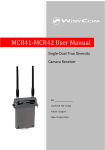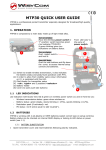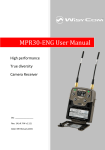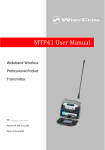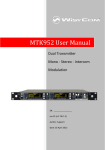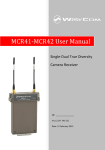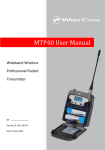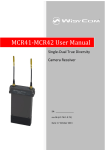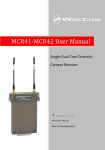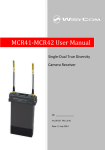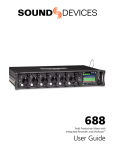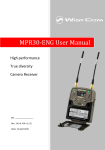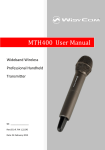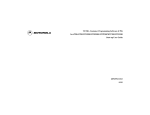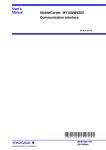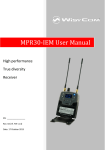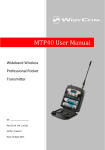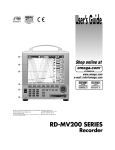Download user manual - Television Film Services
Transcript
INSTRUCTION MANUAL MCR 41 MCR 42 DUAL TRUE DIVERSITY WIRELESS CAMERA RECEIVER STAND ALONE AND SLOT IN EXECUTIONS MCR41/MCR42 s.n.: __________________ FW rev: __________________ Options: __________________ MCR42 dual true diversity receiver Pag. 2 high performances microphone system Brief description Table of contents The MCR42 is a high performance microphone receiver suitable for broadcast and high professional applications. Brief description�������������������������������������� 3 Thanks to Wisycom movable filter technology, MCR42 is able to work in a bandwidth up to 240 MHz, still keeping an exceptional selectivity and intermodulation immunity. This miniature design allows to integrate a DUAL TRUE DIVERSITY receiver while keeping a small size to fit camera slot in: - Ikegami/Panasonic (UNISLOT™); - Philips/Thomson/Grass Valley; - Sony. Safety instruction ����������������������������������������������� 4 Main features ����������������������������������������������������� 4 Technical description������������������������������ 5 User guide���������������������������������������������������� 6 FRONT PANEL���������������������������������� 6 Display menu ���������������������������������� 7 MAIN MENU ����������������������������������������������������� 7 HEADPHONE����������������������������������������������������� 7 POWER ON������������������������������������������������������� 7 EDIT RX1/RX2��������������������������������������������������� 7 EDIT RX1:GR-Ch����������������������������������������������� 7 EDIT RX1: Frequency��������������������������������������� 8 EDIT RX1: Squelch������������������������������������������� 8 EDIT RX1: Expander����������������������������������������� 8 EDIT RX1: Tone Squelch����������������������������������� 8 EDIT RX1: Config (squelch/PTT) ������������������������� 8 EDIT RX1: Audio Out ��������������������������������������� 8 EDIT RX1: Sig. Phase����������������������������������������� 8 EDIT RX1: Scan ����������������������������������������������� 8 The audio receiver block is fully digital to allow a better quality, digital output and emulation of most of companding chipsets. It supports also AES3 audio output with an overall sounds delay below 1.5 msec. Rear Panel �������������������������������������� 9 MCR42 is designed to be: Slot in sockets���������������������������������� 9 ••“easy & quick to use” thanks to automatic setup functions (i.e. frequencies, squelch, scan), remote configuration utilities (thru infrared), an OLED display with intuitive context menu navigation. Specifications �������������������������������� 10 CE Declaration�������������������������������� 11 Stand alone socket ������������������������������������������� 9 SLK 42-IK (Panasonic)��������������������������������������� 9 SLK 42-PH (Grass Valley)����������������������������������� 9 SLK 42-SX (Sony)��������������������������������������������� 9 ••“extremely flexible”, with an incredible frequency agility up to 240 MHz. Moreover the DSP board allows analogue and digital (AES3) output, with multi-companding compatibilities and other digital features. ••“best in class performances”, thanks to the latest Wisycom technology the unit has extreme RF sensitivity and immunity and superb audio quality. ••“a durable & upgradable investment”, thanks to the very robust design (aluminum housing) and the possibility to upgrade/enhance units performances. Moreover MCR42 system is already set up for the exclusive PTT function (remote command), developed and patented by Wisycom and now appreciated in the broadcast world: Simply pushing this button (PTT), the presenter causes the remote switching of the receiver’s output-line, from the “main line” to the additional “intercom line”, in order to be able to talk “off-air” directly with the technical team. Then all PTT’s MICs can be connected in pre-fading allowing a clever intercom setup. Pag. 3 MCR42 dual true diversity receiver Safety instruction ••Read this safety instruction and the manual first. ••Follow all instructions and information. ••Do not loose this manual. ••Do not use this apparatus under the rain or near the water. ••Do not install the apparatus near heaters or in hot environments, do not use outside the operating temperature range. ••Do not open the apparatus, only qualified service technician are enabled to operate on it. The apparatus needs servicing when it is not properly working or is damaged by liquids, moisture or other objects are fallen in the apparatus. ••Use only accessories or replacement parts authorized or specified by the manufacturer. ••Clean the apparatus only with dry cloths, do not use liquids. ••Report the serial number and the purchasing date in front of the manual. It is needed to have proper replacement parts or accessories from the manufacturer. ••When replacement parts are needed, use only replacement parts authorized from the manufacturer. Substitution with not authorized parts could result in electric shock, hazards or fire. »» Keep attention on all the labels with warnings or hazards on the apparatus. WARNING: The apparatus is intended for professional use; anyway the manufacturer alerts the user that the headphone output power of the apparatus could exceed the level of 85 dB(A) of sound pressure level and this could be dangerous for the hearings. Do not use the headphone with high power level or for long time. Reduce the power or suspend the hearing in case of any kind of hearing problem. WARNING: when operating thru battery pack always replace ALL BATTERIES. DO NOT operate the device with some new and some old batteries. When MCR42 is setup to “automatically turn on”, DO CHANGE ALL OF USED BATTERIES after automatic low batteries shutdown. Pag. 4 Main features MCR41/42(*) is a camera dual true diversity wireless-microphone receiver system in a modular standalone or slot-in configuration (compatible with most camera’s slot): ••Extreme RF (radiofrequency) performances and reliability ••Extreme frequency agility (tuning windows up to 240 MHz with independet tunables filters on 2 ch’s): »» »» MCR42-L: 470/678 MHz (TV ch 21/46) MCR42-H: 590/822 MHz (TV ch 36/65) (extended range up to 830 available on request and upon your country-specific regulations) ••digital output on AES3 ••multi-companding compatibility ••future digital functionality enhancements ••Automatic scan for best channels, squelch and other automatic setup ••Infrared interface (i.e. for system setup, microphone programming) ••Automatic transmitter re-programming (thru infrared, sync function) ••Push to Talk (PTT) function with additional audio output signals (patented) (*) Note MCR41 is the version with only one diversity RX board mounted. It supports all features of MCR42 and is compatible with MCR42 Firmware. It is also possible to mount the second Rx board to upgrade a MCR41 to an MCR42. high performances microphone system Technical description The MCR42 is a professional dual true diversity receiver for wireless microphones reception especially designed for broadcast production, live stages, theatres and top professional applications. It’s winning performances are: ••High immunity on strong RF environment ••Huge switching bandwidth ••High audio performances and flexibility with analog or digital processors Front panel Receiver supervisor microcontroller and user interface Analogue output Digital output Receiver - 2- B Digital audio processor AES3 Output Line 1 & 2 PTT output Receiver - 2- A B True Diversity Control Rx 2 Antenna inputs Receiver - 1- B Line 1 Line 2 Com Rx 1 Com Rx 2 Earphone Receiver - 1- A Ear-ph Left Ear-ph Right Communic. and control interface A True Diversity Control Rx 1 ••High reliability and durability INFRARED SERIAL LINK MCR42: main block diagram One of the milestones in the design of the MCR42 is high reliability: most of the circuitry of the receiver is independent one from each other. Above a schematic with an overview of main receiver functions. For each antenna the RF signal is split in the receiver 1 and in the receiver 2 (antenna A and antenna B) with a wide band splitter. In this way any one receiver could be tuned in any frequency of the switching range (typ. 240 MHz). Receiver 1 and 2 are diversity receivers: each one is made of two receivers tuned on the same frequency, hereafter called section A and section B. The receiver 1 section A and the receiver 2 section A are connected to the antenna A, the receiver 1 section B and the receiver 2 section B are connected at the antenna B. Each receiver has its own demodulated signal and its own RSSI signal (Receiver Signal Strength Indication); a DSP selects or combines signals from section A & B to have the best audio. The demodulated signal flows to the digital audio processor. Data signalling detection and demodulation: the data sub carrier is digitally filtered to a very selective equivalent bandwidth (3Hz). Each filter has its own data demodulator, one for medium speed data detection at the output of the first filter and one at low speed data detection at the output of the second filter. All the two demodulators are connected to the supervisor micro controller for the data battery detection and signalling. Digital audio processor: the demodulated signal is filtered by an anti aliasing low pass filter and then converted in the digital domain with a 96KHz 24bit audio A/D converter. The digital signal processor (DSP), working in double precision, replicates all the analog functions with very high accuracy, ultra low distortion and without typical analog problems like components tolerances or long term drifts or temperature drifts etc. The high speed audio algorithms implemented in assembler into the MCR42 maintains the audio delay at about 1.3 milliseconds, making it ideally for live events and to keep audio delay as short as possible. The DSP unit also filters and demodulates the data carrier and communicates all the parameters and informations to the supervisor micro controller. The audio output goes to the digital outputs (AES3) or is converted in the analog domain with a high quality 24 bits 96KHz D/A converter and an anti-aliasing filter. Pag. 5 MCR42 dual true diversity receiver User guide H D E A B C FRONT PANEL MCR42 allows an easy and quick configuration using buttons, RGB LED’s and an OLED display. The front panel is functionally divided in the following section: A B SMA antenna Connector: MCR42 is supplied with a couple of antenna tuned on 400 MHz bandwith suitable to be used with both MCR42-L and MCR42-H version. C RGB Leds: Each of the 2 receivers has a dedicated set of LED’s to give a clear indication of its status. “ON LED” OFF Relative receiver is not active GREEN Relative receiver is active and battery/external power is not low RED Relative receiver is active and battery/external power is low BLINKING Relative trasmitter battery is low: - slowly blinking if 25% lifetime - quickly blinking if 12% lifetime “RF LED” OFF Relative receiver is not active RED RF level below squelch on both diversity receivers GREEN RF level above squelch and receiver A is active (ANTENNA A) BLUE RF level above squelch and receiver B is active (ANTENNA B) “AUDIO LED” RED Audio muted due to RF squelch or tone squelch GREEN Audio active & tone squelch detected BLUE Pag. 6 G F Audio active & tone squelch not detected D “MENU/SEL” BUTTON Push this button to navigate function menu’s and to confirm the choosen setup. F “PWR/EXIT” BUTTON Push and keep this button to power on/off the receiver. The on/off status is permanently memorized into the non-volatile memory, this way the system can be setup to automatically turn on Rx1, or Rx2, or both, when power up. During menu navigation push this button to exit from current menu (escape function). E “Arrow up/sync” BUTTON Push and keep this button to start a syncronization with a Wisycom transmitter (follow instructions on display). Before starting syncronization IRDA must be enabled on Wisycom transmitter. During menu navigation push this button to move -up and select the previous item. G “Arrow down/scan” BUTTON Push and keep this button to start the automatic scan. During menu navigation push this button to movedown and select the previous item. H “OLED Display” The receiver has a high contrast display. Pushing a button while the receiver is active, turn on automatically the display. After a time-out the display turns off automatically. high performances microphone system Display menu Following a draft of MCR42 menu’s structure. Main Menu Headphone Volume Rx Signal Edit Rx1 Gr. Ch Frequency Squelch Expander Tone Sq. Audio Out Sig. Phase Scan Edit Rx2 Gr. Ch Frequency Squelch Expander Tone Sq. Audio Out Sig. Phase Scan Contrast On Timeout Power Model Serial Range Option Boot Loader Application Base Power on LINE mode Display Infrared Sync Info Fact. Preset Using navigation buttons it is possible to quick & easy navigate through the MCR42 menu: - Sel/Exit to enter or exit a level - Arrow up/down to circle on the same level MAIN MENU RX1 POWER ON To enable each of the two true diversity receiveirs: Rx1 & Rx2, just Rx1 or just Rx2. RX2 Group Channel EDIT RX1/RX2 RF Bar Audio Bar Frequency Squelch Level HEADPHONE Left and right channel of stereo jack can be mapped respectively on line 1 & 2 or on a Line 1 + Line 2. Cycle through menu’s with up/down arrow to get your desired configuration then confirm with SEL. It is possible to set the desired output level from Max (+6 dB) to min (-24 dB) in 1 dB step. Selecting this sub-menu most of RX1 setups are configurable. EDIT RX1:GR-Ch Select current group and channel. Group name and channel frequency are displayed on the right. Pag. 7 MCR42 dual true diversity receiver EDIT RX1: Frequency EDIT RX1: Config (squelch/PTT) If the specific group/channel is not locked, then can be edited in this menu. When tone squelch is on, output matrix between line and com (PTT) can be configured. EDIT RX1: Squelch This menu allows to disable the RF squelch or to setup the desired squelch level in dBuV (note 0 dBuV is equal to -107 dBm). EDIT RX1: Expander MCR42 core is a power digital audio processor that, besides an unbeatable audio quality and flexibility, can emulate most companders systems on the market. On this menu you can setup the audio companding chipset emulation. ENR is emulating the Philips™ SA572 and PTT digital data of Wisycom transmitters. Other setups can be loaded on request. When tone squelch is in advanced mode, then it is possible to access a more complex audio matrix. Usually Line is always thicked and Com (PTT) is thicked on “PTT psh.” as additional return channel (intercom). EDIT RX1: Audio Out It is possible to set the nominal audio from +6dBu and -24 dBu in one dB step. EDIT RX1: Sig. Phase EDIT RX1: Tone Squelch To change audio phase of 0 deg or 180 deg. EDIT RX1: Scan MCR42 is able to detect a digital tone squelch generated by a Wisycom transmitters (MTH300/MTP30). Tone squelch ON: when the tone squelch is enabled the audio is muted unless the correct carrier is detected. Tone squelch allows to work with lower RF squelch, increasing the coverage and the robustness especially in presence of digital television carriers (DVB-T). Tone squelch ADVanced: when tone squelch is in advanced mode the receiver processes also PTT data (push to talk): activating the command audio output when the button is pressed on remote trasmitter. Pag. 8 This function can be called also using the dedicated scan button (push and keep). It allows to make a scan over a desired frequency group. MCR42 manages up to 2400 custom frequencies organized in 40 groups of 60 channels each. This extreme flexibility makes the scan function very flexible. high performances microphone system Once started a scan operation the receiver asks for group to be used. Rear Panel Stand alone socket Then it prompts to turn off all transmitters. Then finally start the scan! Power Com 1 & 2 Line 2 Line 1 AES3 (Line 1 & 2) The standalone socket BPA 42 PTT supplies the following connections: After few seconds, scan results are displayed on a chart. Results can be also displayed sorted by level, making easier to pick up the best one. As per Wisycom standard, group 0 and group 9 are special; respectively the “center frequency” (474,482/... MHz) and the intergap frequency (i.e. 470/478/486/... MHz). A scan on group 0 will reveal in few seconds the overall DVB-T occupation on the area, while a scan on group 9 will give possible working frequency, usable also in presence of strong DVB-T signal (sort to speak working in the bandguard of 2 digital television channel). Analogue Audio Output (Line 1 & 2) • Audio line-output 1 & 2 : electronically balanced on two 3 pin mini-XLR Female connector • Audio line-output level : Adjustable in a one dB step between -20 and +6 dBu (nominal) and MAX +12 dBu (peak deviation) • Audio line-output imped. : ≤ 200 ohm. Push to Talk (PTT) Audio Output (Com) • PTT line-output 1 & 2 : electronically balanced on a 5 pin mini-XLR Male connector Digital Audio Output AES3 • Digital line-output 1 & 2 : electronically balanced on 3 pin mini-XLR Male connector • Digital line-output : AES3 @ 48 kHz Slot in sockets To transform MCR42 in slot-in compatible for a specific camera you need to use a kit with a rear-panel and a flange. SLK 42-IK for - Panasonic - IKEGAMI SLK 42-PH for - Grass Valley - Thomson S1LK 42-SX - Sony Pag. 9 MCR42 dual true diversity receiver Specifications • Frequency ranges : MCR42 L ⇒ option 470 ÷ 678 MHz ([1]) MCR42 H ⇒ option 590 ÷ 822 MHz (830 MHz [1]) • Switchable channels : 40 groups of 60 channels fully user progr. • Switching-window : up 240 MHz [1]. • Frequencies : microprocessor controlled frequency synthesizer circuit, with 25 kHz minimum step. The frequencies is easily PC reprogrammed with the optional UPK 300E Programming Kit. • Frequency error : < ± 2.5 ppm, in the rated temperature range. • Temperature range : -10 ÷ +55 °C. • Modulation : FM, with 50 µs de-emphasis. • Nominal deviation : ±40 kHz (Max. operating dev. = ± 60 kHz). • “A” / “B” antenna inputs : with sturdy connectors. • Antenna input impedance: 50 ohm sma type (SWR < 1:2; typ. 1:1.4). • Sensitivity : ⇒ 2 µV ( 0 dBµV), for SND/N> 58 dB; ⇒ 5 µV (14 dBµV), for SND/N> 98 dB. in the whole switching-window [2]. • Amplitude response : < 0.5 dB (RF input sig.:6 dBµV ÷ 100 dBµV). • Co-channel rejection : > 2.5 dB. • Adjacent chan. selectivity : > 80 dB typical (for ch. spacing ≥ 400 kHz). • Spurious rec. rejection : > 100 dB. • IF image rejection : > 90 dB. • Intermod. rejection : > 76 dB. • IIP3 : > +10 dBm typical. • Spurious emissions : < 2 nW (typical = 0.1 pW). • Noise Reduction system : DSP multi-compander emulation: ⇒ ENR (Wisycom Extended-NR) ⇒ Others, compatible with most systems, thru an internal DSP emulation of SA572, SA575 and Rms envelope compander chip set, fully user programmable • AF bandwidth : 30 Hz ÷ 20 kHz. • Frequency response : ± 0.5 dB in the 30 Hz ÷ 19 kHz range. • Distortion : 0.3 % typical. • SND/D ratio (Analogue) : 110 dB typical [2] • SND/D ratio (AES3) : >125 dB typical [2] • Powering : - External = 4 ÷ 18 Vdc (1.5 W max). - Auton. = with optional BCA 42 Battery Module (5 x IEC-LR6 1.5V size-AA alkaline or rechargeable elements). • Dimensions : “Slot-in” execution= 68 x 18 x 115 mm, “Stand-alone” exec. = 68 x 18 x 135 mm. • Weight : 180 g approx. NOTE [1]: Extended limits or other custom ranges are available on request, if allowed by your country-specific regulation. NOTE [2]: RMS value, 22 Hz / 22 kHz, unweighted. ITALY ONLY Obblighi di informazione agli utilizzatori Modello di informazioni agli utenti dei prodotti di tipo “professionale” INFORMAZIONE AGLI UTENTI ai sensi dell’art. 13 del Decreto Legislativo 25 luglio 2005, n. 151 “Attuazione delle Direttive 2002/95/CE, 2002/96/CE e 2003/108/CE, relative alla riduzione dell’uso di sostanze pericolose nelle apparecchiature elettriche ed elettroniche, nonché allo smaltimento dei rifiuti” Il simbolo del cassonetto barrato riportato sull’apparecchiatura o sulla sua confezione indica che il prodotto alla fine della propria vita utile deve essere raccolto separatamente dagli altri rifiuti. La raccolta differenziata della presente apparecchiatura giunta a fine vita e’ organizzata e gestita dal produttore. L’utente che vorrà disfarsi della presente apparecchiatura dovrà quindi contattare il produttore e seguire il sistema che questo ha adottato per consentire la raccolta separata dell’apparecchiatura giunta a fine vita. L’adeguata raccolta differenziata per l’avvio successivo dell’apparecchiatura dismessa al riciclaggio, al trattamento e allo smaltimento ambientalmente compatibile contribuisce ad evitare possibili effetti negativi sull’ambiente e sulla salute e favorisce il reimpiego e/o riciclo dei materiali di cui è composta l’apparecchiatura. Lo smaltimento abusivo del prodotto da parte del detentore comporta l’applicazione delle sanzioni amministrative previste dalla normativa vigente. The MCR42 Receiver System complies with ETSI ETS 300 422. Pag. 10 high performances microphone system CE Declaration Pag. 11 WISYCOM srl Via Spin, 156 • I-36060 Romano d’Ezzelino • Italy Tel. +39-0424-382605 • Fax +39-0424-382733 www.wisycom.com • e-mail:sales @ wisycom.com WISYCOM srl reserves the right to make changes at any time and without prior notice Printed in Italy - MCR42 User manual - 21 September, 2010 11:37 AM












